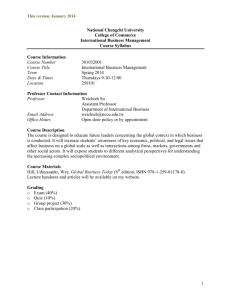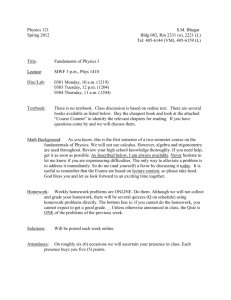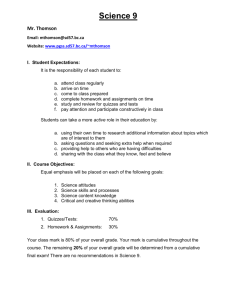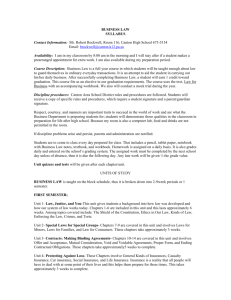Introduction to Astronomy
advertisement
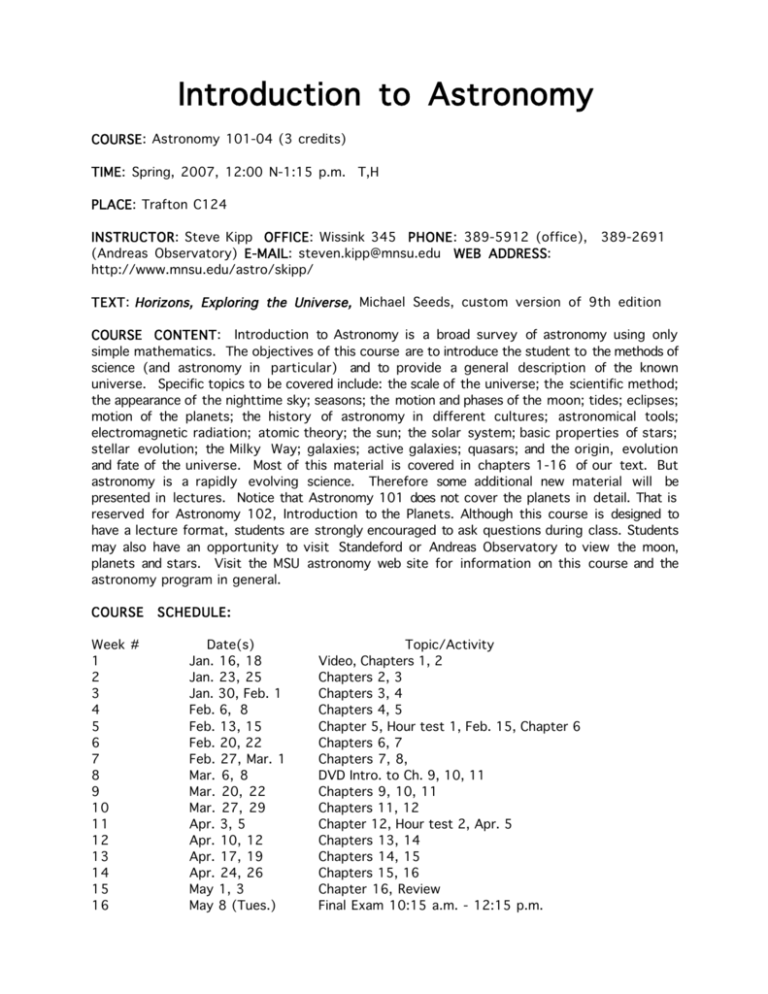
Introduction to Astronomy COURSE: Astronomy 101-04 (3 credits) TIME: Spring, 2007, 12:00 N-1:15 p.m. T,H PLACE: Trafton C124 INSTRUCTOR: Steve Kipp OFFICE: Wissink 345 PHONE: 389-5912 (office), (Andreas Observatory) E-MAIL: steven.kipp@mnsu.edu WEB ADDRESS: http://www.mnsu.edu/astro/skipp/ 389-2691 TEXT: Horizons, Exploring the Universe, Michael Seeds, custom version of 9th edition COURSE CONTENT: Introduction to Astronomy is a broad survey of astronomy using only simple mathematics. The objectives of this course are to introduce the student to the methods of science (and astronomy in particular) and to provide a general description of the known universe. Specific topics to be covered include: the scale of the universe; the scientific method; the appearance of the nighttime sky; seasons; the motion and phases of the moon; tides; eclipses; motion of the planets; the history of astronomy in different cultures; astronomical tools; electromagnetic radiation; atomic theory; the sun; the solar system; basic properties of stars; stellar evolution; the Milky Way; galaxies; active galaxies; quasars; and the origin, evolution and fate of the universe. Most of this material is covered in chapters 1-16 of our text. But astronomy is a rapidly evolving science. Therefore some additional new material will be presented in lectures. Notice that Astronomy 101 does not cover the planets in detail. That is reserved for Astronomy 102, Introduction to the Planets. Although this course is designed to have a lecture format, students are strongly encouraged to ask questions during class. Students may also have an opportunity to visit Standeford or Andreas Observatory to view the moon, planets and stars. Visit the MSU astronomy web site for information on this course and the astronomy program in general. COURSE Week # 1 2 3 4 5 6 7 8 9 10 11 12 13 14 15 16 SCHEDULE: Date(s) Jan. 16, 18 Jan. 23, 25 Jan. 30, Feb. 1 Feb. 6, 8 Feb. 13, 15 Feb. 20, 22 Feb. 27, Mar. 1 Mar. 6, 8 Mar. 20, 22 Mar. 27, 29 Apr. 3, 5 Apr. 10, 12 Apr. 17, 19 Apr. 24, 26 May 1, 3 May 8 (Tues.) Topic/Activity Video, Chapters 1, 2 Chapters 2, 3 Chapters 3, 4 Chapters 4, 5 Chapter 5, Hour test 1, Feb. 15, Chapter 6 Chapters 6, 7 Chapters 7, 8, DVD Intro. to Ch. 9, 10, 11 Chapters 9, 10, 11 Chapters 11, 12 Chapter 12, Hour test 2, Apr. 5 Chapters 13, 14 Chapters 14, 15 Chapters 15, 16 Chapter 16, Review Final Exam 10:15 a.m. - 12:15 p.m. The course schedule is approximate and is subject to change. Changes will be announced in class. GRADING: There will be two hour tests, five pop quizzes, and a final exam in this course. An optional extra credit project will be described elsewhere. The first hour test will be given after covering chapters 1-5; and the second hour test will be given after covering chapters 6 12. The final exam is comprehensive but will emphasize material not covered on previous hour tests. The hour tests and final exam will be worth 50 points each. The pop quizzes will be worth 5 points each. Pop quizzes will be given without announcement and may not be made up! However your lowest quiz score will be dropped without penalty. Hour tests may be made up if there is sufficient justification. However, makeup tests may be all or part essay tests. The total possible points is 170. Your final score will be the percentage of this total you receive. The extra credit project will be worth up to 10 points. The final grading scale, based on past performance in this course, is as follows: Percentage Score [85 - 100] [74 - 85) [61 - 74) [50 - 61) < 50 Grade A B C D F All the material presented in the text and during lectures is potential hour test, final exam and pop quiz material. This includes pictures, diagrams, tables, demonstrations, videos and slides as well as written text. The hour tests, final exam and pop quizzes are designed to test both your memory and understanding of course material. Some questions will ask you to reason beyond what you know directly and make educated guesses like a scientist. The final exam, hour tests and pop quizzes will consist mostly of multiple choice and/or matching questions. The final exam will be comprehensive and will contain some questions from the previous hour tests and pop quizzes. The pop quizzes will cover material recently discussed in class. No electronic devices may be used during the hour tests, quizzes and exam. Students are expected to be honest and responsible in the accomplishment of their academic work. All the work you turn-in must be solely your own and not the result of collaboration with anyone else. Although attendance will not be taken, regular class attendance is expected consistent with the University’s attendance policy. Course grades of incomplete will be given according to University policy. In order to keep track of student business, I ask that you put requests for making up an hour test, getting an incomplete and similar matters in writing including your name and Tech Id number. (I expect all students to know their Tech Id numbers.) STUDY S K I L L S : Introduction to Astronomy is a more difficult than average general education course. In order to do well it is suggested that you read the text in advance of the lecture, listen to the lecture, asking questions and taking notes, and review the book after the lecture. Before each lecture make a general review of your notes. To prepare for a test it is very helpful to study with a classmate. Pay special attention to the boldface terms in the text. To help prepare students for astronomy tests, I have assembled a sample question booklet called the Student's Manual of Astronomy Questions. The booklet is available from the Wissink copy shop. OFFICE HOURS: Regular office hours are posted at my office. They will also be announced in class. In addition to the listed hours I will be glad to meet with students by appointment. Feel free to drop by.


